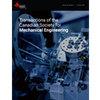Analysis on parametric vibration of hydraulic opposing cylinders controlled by a servo valve considering pressure pulsation
IF 1
4区 工程技术
Q4 ENGINEERING, MECHANICAL
Transactions of The Canadian Society for Mechanical Engineering
Pub Date : 2022-11-18
DOI:10.1139/tcsme-2021-0192
引用次数: 0
Abstract
During the working process of the system of hydraulic opposing cylinders controlled by a servo valve, the fluid equivalent stiffness changes dynamically due to the pressure pulsation of the pump source. Therefore, the transmission system has obvious nonlinear effects, and its dynamic performance is difficult to improve further. Thus, a nonlinear dynamic model of the system of hydraulic opposing cylinders controlled by a servo valve was established. By using the multiscale method, the steady-state approximate solutions of the primary resonance and the combination resonance of the system were derived to reveal their characteristic laws. The results showed that the dominant frequency of the system's primary resonance is the frequency of the external excitation source, and the dominant frequency of the system's combination resonance is the sum of the natural frequency of each order and the fluctuation frequency of the fluid equivalent stiffness. The amplitude of the combination resonance was smaller than that of the primary resonance. The maximum error between the theoretical natural frequency and the experimental modal frequency was 3.77%, which verified the correctness of the system's nonlinear dynamic model. The research can provide a theoretical reference for the dynamics optimization design of the hydraulic transmission system.考虑压力脉动的伺服阀控制液压对置缸参数振动分析
在伺服阀控制的液压对置缸系统工作过程中,由于泵源压力脉动,流体等效刚度发生动态变化。因此,传动系统具有明显的非线性效应,其动态性能难以进一步提高。在此基础上,建立了伺服阀控制液压对置缸系统的非线性动力学模型。利用多尺度方法,推导了系统主共振和组合共振的稳态近似解,揭示了它们的特征规律。结果表明:系统主共振的主导频率为外部激励源的频率,系统组合共振的主导频率为各阶固有频率与流体等效刚度波动频率之和。组合共振的幅值小于主共振的幅值。理论固有频率与实验模态频率的最大误差为3.77%,验证了系统非线性动力学模型的正确性。研究结果可为液压传动系统的动力学优化设计提供理论参考。
本文章由计算机程序翻译,如有差异,请以英文原文为准。
求助全文
约1分钟内获得全文
求助全文
来源期刊
CiteScore
2.30
自引率
0.00%
发文量
53
审稿时长
5 months
期刊介绍:
Published since 1972, Transactions of the Canadian Society for Mechanical Engineering is a quarterly journal that publishes comprehensive research articles and notes in the broad field of mechanical engineering. New advances in energy systems, biomechanics, engineering analysis and design, environmental engineering, materials technology, advanced manufacturing, mechatronics, MEMS, nanotechnology, thermo-fluids engineering, and transportation systems are featured.

 求助内容:
求助内容: 应助结果提醒方式:
应助结果提醒方式:


